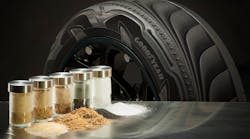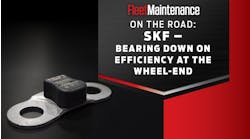The Goodyear Tire & Rubber Company unveiled a demonstration tire comprised of 90% sustainable-material content. This demonstration tire has passed Department of Transportation testing and is approved for road use.
This demonstration tire also tested to have lower rolling resistance when compared to the reference tire, made with traditional materials. Lower rolling resistance means this demonstration tire has the potential to offer better fuel savings and carbon footprint reduction.
Bringing a 90% sustainable-material tire to market will require further collaboration with the company’s supply base to identify the scale necessary for these innovative materials to produce that specific tire at high volumes.
“Last January, we announced a 70% sustainable-material tire, and while we celebrated this accomplishment, we knew it set the foundation for us to continue to push forward,” said Chris Helsel, senior vice president, global operations and chief technology officer. “Over the past year, we researched new technologies, identified opportunities for further collaboration, and utilized our team’s ingenuity and tenacity to achieve this tremendous accomplishment, increasing the sustainable-material content used in a tire by 20 percentage points. This validates our goal of introducing the first 100% sustainable-material tire in the industry by 2030.”
The 90% sustainable-material demonstration tire includes 17 featured ingredients across 12 different components, including:
- Carbon black, which is included in tires for compound reinforcement and to help increase their life, has traditionally been made by burning various types of petroleum products. Goodyear’s 90% sustainable-material demonstration tire features four different types of carbon black that are produced from methane, carbon dioxide, plant-based oil, and end-of-life tire pyrolysis oil feedstocks. These carbon black technologies target reduced carbon emissions, circularity, and the use of bio-based carbons, while still delivering on performance.
- The use of soybean oil in this demonstration tire helps keep the tire’s rubber compound pliable in changing temperatures. Soybean oil is a bio-based resource that helps to reduce Goodyear’s use of petroleum-based products. While nearly 100% of soy protein is used in food/animal feed applications, a significant surplus of oil is left over and available for use in industrial applications.
- Silica is an ingredient often used in tires to help improve grip and reduce fuel consumption. This demonstration tire includes a high-quality silica produced from rice husk waste residue (RHA silica), a byproduct of rice processing that is often discarded and put into landfills.
- Polyester is recycled from post-consumer bottles by reverting the polyester into base chemicals and reforming them into technical grade polyester used in tire cords.
- Resins are used to help improve and enhance tire traction performance. In this demonstration tire, traditional petroleum-based resins are replaced with bio-renewable pine tree resins.
- Bead wire and steel cords provide reinforcement in the structure of a radial tire. This demonstration tire uses bead wire and steel cord from steel with high-recycled content, which is produced using the electric arc furnace (EAF) process. The utilization of the EAF process allows for steel to be produced with reduced energy use and higher recycled content. The EAF process has the potential for lower greenhouse gas emissions in comparison with steel produced using a blast furnace.
The shift to sustainable materials is evident in some of Goodyear’s current product lines. Today, eight product lines, and some racing tires, include soybean oil. In addition, Goodyear has more than doubled its use of RHA silica in its product lines since 2018.



